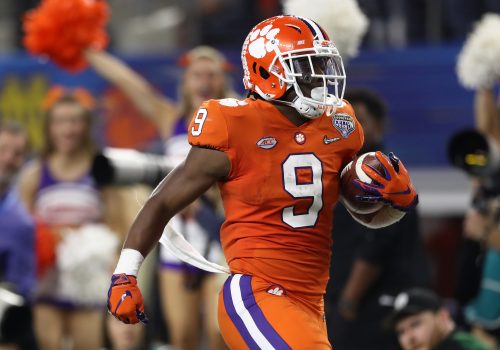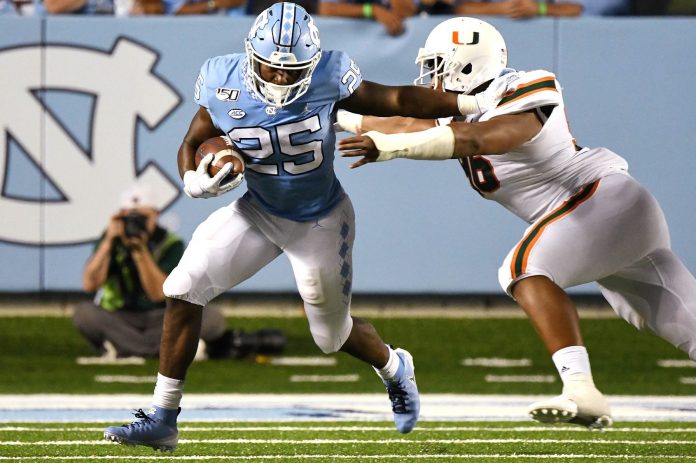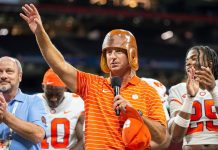While running backs are obviously not a high concern for general managers with early draft picks, there is a group in this year’s draft that will certainly be on the radar.
Experts around the country are debating which backs deserve first round status. With Pro Football Focus’ release of the running back rankings on Monday, and Javonte Williams placed atop the class, a huge discussion has been sparked.
Is the ACC’s all-time rushing leader in Travis Etienne actually a better back? The common answer is yes. The consensus seems to be that Williams may be a better pure rusher but Etienne is the more complete package.
But let’s dig a little deeper.
Javonte Williams: A force to be reckoned with
First off, we should establish what the hype about Javonte Williams is really about. Williams put himself on the map this year with highlight reel runs and a historic number of broken tackles.
This run by Javonte Williams was absolutely ridiculous! 👏🏾
UNC has over 400 rush yards today and the game isn't even over yet 😳 pic.twitter.com/syhAnzUMAY
— Maria Taylor (@MariaTaylor) December 12, 2020
While he was an impact player previously, it was 2020 where Williams’ stock really took off. He averaged over 100 yards rushing and two touchdowns per game, all while carrying the ball less than 15 times.
He is mostly touted for his explosiveness through the second level and ability to work downhill. The question is whether certain weaknesses may hold him back.
Is Williams Built for the NFL game?
As players progress from the college level to the NFL, the competition obviously improves in all aspects. But perhaps to an even larger extent, the tackling improves and many players that rely on open field elusiveness must adapt.
Williams somewhat lacks perimeter speed, but compensates with vision and ability to penetrate through the gaps of the defense. Therefore, it seems pretty safe to say that he could establish himself at a high level.
Is he built to last? That is a more difficult question. Running backs have short shelf lives to begin with and the way Williams plays may magnify that trend. There are always the Frank Gores out there that defy human nature but in general, Williams’ durability will be tested. The good news is that he does not have a major injury history by any means.

Etienne’s Potential Advantage
Etienne’s running style aligns perfectly with the NFL game. He reads defenses extremely well and is certainly a north-south rusher. He also has slightly more breakaway speed than Williams.
However, the main difference that makes Etienne intriguing is his versatility. While Williams works best in a one-cut style offense, Etienne shows very little scheme dependence. He is explosive enough to thrive in a zone offense but is also patient enough to allow gaps to develop as necessary.
Obviously, Williams may get drafted by the right team and his ceiling is endless in that case. But Etienne is more likely to get picked higher, simply because more teams value his skill set.
Dislodging the Receiving Narrative
In today’s NFL, a running back needs to be able to provide value in the passing game in order to stay on the field for three downs. At North Carolina, Williams was used in a smaller role in passing situations compared to Etienne at Clemson. But if routes run behind the line of scrimmage are factored out, Williams was actually a more productive receiver.
| Routes Run | Catch Rate (Per Route Run) | Catch Rate (Per Target) | |
| Javonte Williams | 158 | 14.6% | 71.4% |
| Travis Etienne | 260 | 13.5% | 65.0% |
Etienne was more heavily relied upon which is why he earned more targets. But Williams was in an offense with other weapons such as Michael Carter, Dyami Brown, and Dazz Newsome. When Williams’ number was called upon, he actually caught passes at a more efficient rate. Furthermore, Williams had a larger average depth of target in these situations.
An Added Component
Williams increases his value with another aspect in which he is elite — pass blocking. On “true pass sets” (excludes plays with less than four rushers, play action, screens, short dropbacks and time-to-throws under two seconds) he allowed pressures on just 26.8% of opportunities, which is in the top ten percentile in the FBS. Etienne was far from a liability in this respect but allowed pressures at a rate of 30.0%.
Putting it All Together
A reasonable argument can be made for Etienne as the better running back but not in the same way many people think. The Clemson product is a simply safer option. Williams, on the other hand, has more upside and is actually the more “well-rounded” player. While he may be drafted lower, it would not be surprising to see Williams churn out a better NFL career.






